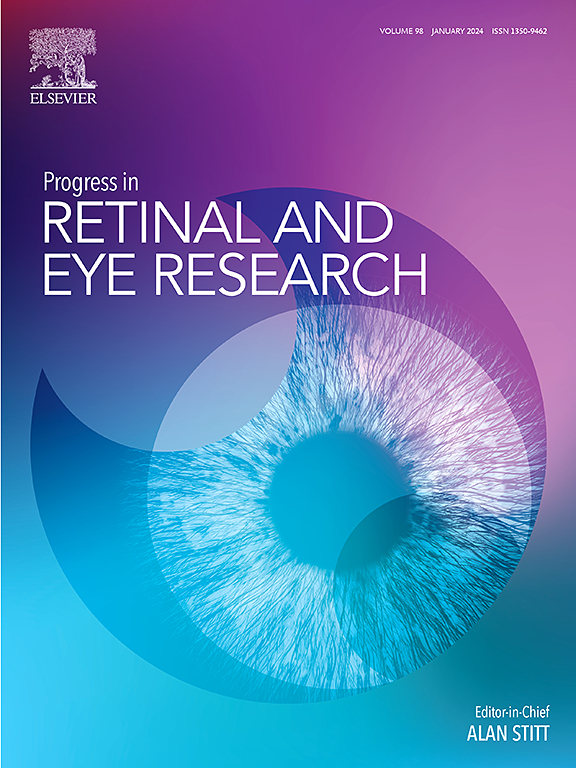视网膜G蛋白偶联受体(RGR)在视力和疾病中的阴暗面和光明面。
IF 14.7
1区 医学
Q1 OPHTHALMOLOGY
引用次数: 0
摘要
视觉发色团 11-顺式视网膜(11cRAL)对脊椎动物的光传导至关重要,因此必须再生才能维持视觉。在光照条件下,由经典视觉周期介导的 11cRAL 再生是不充分的。视网膜 G 蛋白偶联受体(RGR)在视网膜色素上皮细胞(RPE)和缪勒神经胶质细胞中表达,可作为另一种视觉循环光异构酶,在强光条件下光生成 11cRAL。虽然被命名为 G 蛋白偶联受体,但 RGR 并没有已知的偶联 G 蛋白。在光异构酶过程中,与 RGR 结合的全反式视网膜(atRAL)会转化为 11cRAL。在此,我们回顾了这一核心反应是如何融入 RPE 和 Müller 细胞视觉循环的。值得注意的是,人类 RGR 基因突变与遗传性视网膜变性和老年性黄斑变性这些损害视力的眼部疾病有关。在本文中,我们全面回顾了 30 年来对这种膜结合蛋白的研究,以了解 RGR 的 i) 在视觉中的生物学作用,ii) 与眼部疾病的关联,iii) 以及在非眼部功能和疾病中的惊人作用。我们讨论了关于 RGR 在介导非经典视觉循环(光生成 11cRAL)中的作用的研究,这些研究观点截然相反。我们强调了当前 RGR 研究正在解决的知识空白。本文章由计算机程序翻译,如有差异,请以英文原文为准。

The dark and bright sides of retinal G protein-coupled receptor (RGR) in vision and disease
The visual chromophore 11-cis-retinal (11cRAL) is essential to vertebrate phototransduction and therefore, must be regenerated so vision can be sustained. 11cRAL regeneration mediated by the classical visual cycle is insufficient under photopic conditions. Expressed in the retinal pigment epithelium (RPE) and Müller glia, the retinal G protein-coupled receptor (RGR) can act as an alternative visual cycle photoisomerase, photogenerating 11cRAL in bright light conditions. While named a G protein-coupled receptor, RGR has no known coupled G protein. In the photoisomerase process, RGR bound all-trans-retinal (atRAL) is converted to 11cRAL. Here, we review how this core reaction integrates into RPE and Müller cell visual cycles. Significantly, mutations in human RGR are associated with inherited retinal degeneration and age-related macular degeneration, ocular diseases impairing vision. In this article, we comprehensively review 30 years of research into this membrane-bound protein, to comprehend RGR's i) biological role in vision, ii) association with ocular disease, iii) and surprising role in non-ocular function and disease. We discuss studies with opposing views on the proposed role of RGR as mediating a non-canonical visual cycle which photogenerates 11cRAL. We highlight knowledge gaps that current RGR research is addressing.
求助全文
通过发布文献求助,成功后即可免费获取论文全文。
去求助
来源期刊
CiteScore
34.10
自引率
5.10%
发文量
78
期刊介绍:
Progress in Retinal and Eye Research is a Reviews-only journal. By invitation, leading experts write on basic and clinical aspects of the eye in a style appealing to molecular biologists, neuroscientists and physiologists, as well as to vision researchers and ophthalmologists.
The journal covers all aspects of eye research, including topics pertaining to the retina and pigment epithelial layer, cornea, tears, lacrimal glands, aqueous humour, iris, ciliary body, trabeculum, lens, vitreous humour and diseases such as dry-eye, inflammation, keratoconus, corneal dystrophy, glaucoma and cataract.

 求助内容:
求助内容: 应助结果提醒方式:
应助结果提醒方式:


